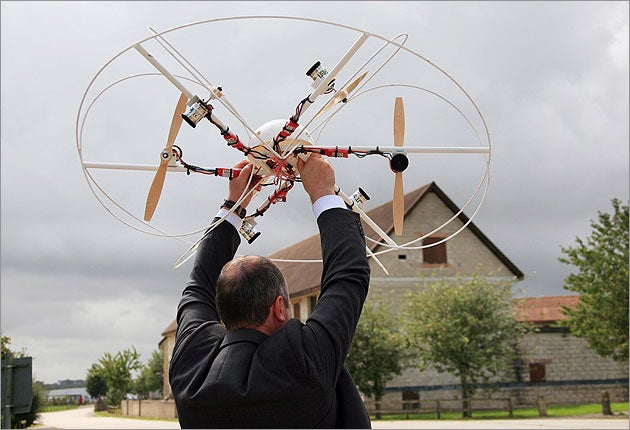The techie challenge to save the lives of soldiers

It's not a sight you see every day. A team of hi-tech robots – some trundling along on caterpillar tracks, others hovering in mid-air like flying saucers – hunting down enemy snipers, lookouts, criminal gangs and road-side bombs. And all in the middle of Wiltshire.
The robots, designed by teams of businesses, universities and schools, were taking part in The Grand Challenge, a Ministry of Defence (MoD) competition to find a device that will help soldiers spot potential enemies and hidden hazards during urban warfare. The designs included mini-helicopters, a hovering flying saucer, gliders and even a moon buggy. The oddest-looking invention came from team Tumbleweed. Its craft comprised a central hub mounted on six propellers.
All contained the latest surveillance, thermal imaging and laser technology designed to help locate threats before soldiers are put in harm's way. The army hopes the technology could help troops locate improvised explosive devices (IEDs), which have killed troops in Iraq and Afghanistan.
The event, which culminated yesterday, has taken place over five days at Copehill Down, on Salisbury Plain, the MoD's purpose-made village used to test soldiers in an urban environment. For the duration of the competition, it has been infested with jeeps, mock-explosives and gunmen.
Though 23 teams submitted entries for the competition, only seven made it through to the finals. They had to complete a "golden hour" in the hazard-laden village, in which they had to spot gangs, bombs and snipers while identifying innocent civilians.
In appalling weather, all the teams had problems with wet equipment. Before the announcement of the winner yesterday, the pits were rife with speculation about who had managed to spot the most threats. Team Thales, with their two mini-helicopters and two hefty, bright yellow ground vehicles, were quietly confident.
Others admitted they had struggled to navigate their vehicles through the wind and rain. The imaginative Team Swarm saw their flying device, powered by four rotors, crash out. The remarkable flying saucer-like craft designed by GFS Projects also fell before the final.
The eventual winner was Team Stellar, made up of six businesses and a group from Cranfield University. Their robot, which looked like Disney's Wall-E character and was called Eugene, won the unanimous judges' decision. Eugene trundles along on caterpillar tracks rather than flying over enemy territory but won because its high degree of automation meant it could operate independently on the battlefield.
"We are a big team, but we have gelled very well – and it's been a lot of fun," said Julia Richardson, the team leader, after picking up the trophy from the television presenter Philippa Forester.
But while the occasion was heaven for the techies, Major Matt Kelly, an urban warfare specialist at Copehill Down, said that the equipment on show would be a real lifesaver on the front line, and that it could be put into practice "in the very near future".
"We will never be able to remove boots on the ground totally, but technology like that on show here will mean that fewer soldiers will be in harm's way," he said. "Urban environments are where wars will be fought in the future and we need to make sure that we stay ahead of our enemies. We've come a long way from the use of binoculars, that's for sure."
Insurgents could soon have a flying saucer hovering at their door.
The MoD will now consider which parts of the technology on show it can put into operation on the front line, but all the winners got was a trophy and the satisfaction of knowing they had done their bit for Queen and country.
The designs
* The winning robot from Team Stellar looks like a grey mini-tank, moves on caterpillar tracks and uses onboard radar, optics and thermal imaging to hunt out targets. It is then able to relay the information in real time to a base camp.
* Team Thales used two mini-helicopters and two ground vehicles in its entry. The helicopters were sent out to send back images for mapping; the ground vehicles, which can move up stairs, have lasers to measure distance.
* Team Tumbleweed's entry, a flat disc shape ringed with six propellers, was one of the more bizarre designs. A pod in the centre of the frame was fitted with cameras and infra-red sensors to track threats.
Subscribe to Independent Premium to bookmark this article
Want to bookmark your favourite articles and stories to read or reference later? Start your Independent Premium subscription today.

Join our commenting forum
Join thought-provoking conversations, follow other Independent readers and see their replies